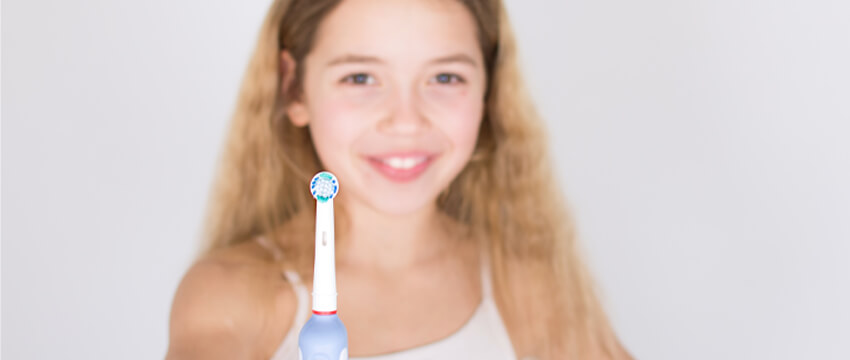Using an electric toothbrush gives you more cleaning power with every stroke, making it an effective method of brushing when wearing braces. If you are undergoing orthodontic treatment, it’s vital that you keep your braces and mouth surfaces ocean and plaque-free. Let’s take an in-depth look at the question ‘can you use an electric toothbrush with braces’, and the considerations to keep in mind when cleaning your orthodontics.
The Complexity Of Oral Hygiene During Orthodontic Treatment
Your mouth is full of bacteria, and each day, the surfaces of your mouth are coated in a sticky film called plaque. The role of brushing and flossing is to remove this plaque to keep bacteria under control and to stop the plaque from calcifying and turning into a substance called tartar. Plaque and tartar play a major role in tooth decay and bad breath.
When you consider the extra structures that orthodontic treatment introduces, you will realise that brackets, elastics, and wires present many more surfaces for plaque and bacteria to cling to. It’s no surprise then, that people wearing braces are advised to brush after every meal. If you don’t, you run the risk of trapping food and debris in your braces.
Another consideration when wearing braces is the need to keep your tooth surfaces as clean as the surfaces below your braces. Part of your tooth is exposed, but a large portion of the tooth is concealed under the brackets. When the day arrives to remove the braces, you want your entire tooth to be in good condition.
Can You Use An Electric Toothbrush With Braces: The Power Of An Electric Toothbrush

Sonic toothbrushes offer you even more cleaning power than a standard electric toothbrush. These toothbrush heads offer up to 30 000 strokes per minute. They combine brush speed and motion technology to remove more plaque. They also promote saliva flow in your mouth, which is an added bonus for plaque removal.
Can An Electric Toothbrush Do Damage To Braces?
We get asked this question a lot, and the short answer is, no. Electric toothbrushes do not damage braces or any of the components of the orthodontic system.
Can Electric Toothbrushes Damage Your Gums?
Gum damage is usually due to too much pressure while you brush, and unlike manual toothbrushes, electric toothbrushes have in-built pressure sensors that alert you when you’re brushing too hard. If anything, electric toothbrushes may protect you against gum damage.
Extra Cleaning Power Actually Helps
If you’re going through orthodontic treatment, it’s likely because your teeth are crooked. When teeth are not straight, they create small, awkward spaces that a standard toothbrush cannot access. This makes you vulnerable to stains and tooth decay. If you consider that you might be wearing braces for 18 to 36 months before your teeth can be straightened out, you’ll appreciate that managing potential tooth decay is of paramount importance.
The Benefits Of Electric Toothbrushes For Orthodontic Treatment
There are no disadvantages to using electric toothbrushes for keeping your braces clean
Get more effective cleaning
Electric toothbrushes can clean the small spaces made by crooked teeth and orthodontics more effectively. They give you more brush strokes every minute and cleaning power that isn’t possible with a manual toothbrush.
Get better results in a shorter timeframe
It could take ages to clean a mouth of braces properly with a manual toothbrush. That’s why so many orthodontists recommend electric toothbrushes for their patients who have braces.
 Make use of the in-built technology
Make use of the in-built technology
Everyone is supposed to brush for two minutes per session, but how many people actually time their brushing?
Most electric toothbrushes have built-in timers that let you know when you’ve achieved the recommended brush time.
Electric toothbrushes can also let you know when you’re brushing too hard, so you don’t damage your tooth enamel or soft tissue.
Customise your cleaning experience
Electric toothbrushes have different modes for different applications. You can select a mode to polish and whiten or clean the surface of your tongue and have peace of mind that the job is being done right every time.
Don’t forget to change the head
Just as a manual toothbrush needs to be replaced, so too should an electric toothbrush head be changed. You can expect to do this every three months on average however most electric toothbrushes have an alert that reminds you to do this. It’s also a good idea to change the head after you have been ill.
While it is possible for members of the same family to share the same toothbrush base, each family member should use their own head for brushing.
So, can you use an electric toothbrush with braces?
Yes, you can use an electric toothbrush with braces. Not only that, it’s actually recommended by orthodontists. When wearing orthodontics, your role is to keep your mouth as clean as possible, and electric toothbrushes give you the opportunity to do that. You can safeguard yourself against the risk of cavities while your teeth are being straightened, as well as protect your tooth surfaces against staining in the most efficient way possible.
To find out more about keeping your braces clean and your mouth plaque-free, please contact us for an appointment: (02) 9159 6237.
References
Can You Use an Electric Toothbrush with Braces?
https://www.waterpik.com/oral-health/edu/brushing/can-you-use-electric-toothbrush-with-braces/
Can you use an electric toothbrush with braces?
https://www.livescience.com/can-you-use-an-electric-toothbrush-with-braces


 Make use of the in-built technology
Make use of the in-built technology